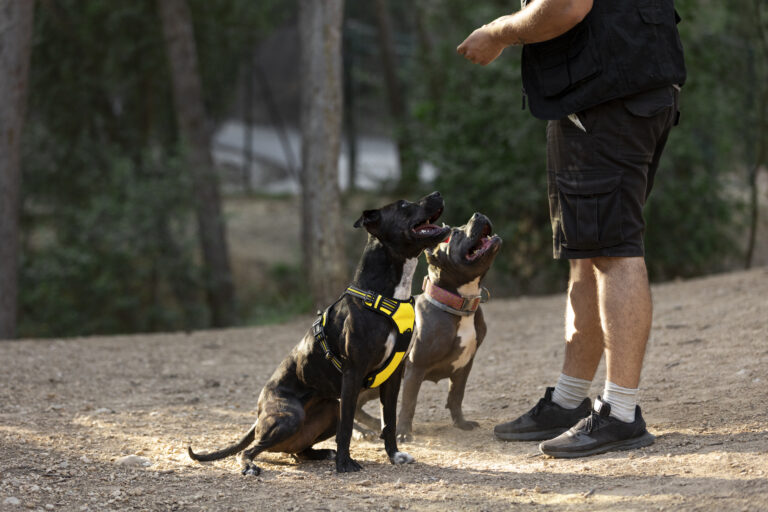Importance of Mental and Physical Stimulation For Your Dog
We stress mental and physical stimulation on a daily basis at our dog training facility in Northern Virginia. The importance of physical and mental exercise cannot be stressed enough as to what it takes in order to raise a perfect dog. Dogs are like people—they need stimulation, they need to get out, and they need to be challenged both physically and mentally. Dogs who are exercised regularly are much happier and healthier than dogs who are not, and the same can be said for people. I always told my friends, family, and clients that whenever I wrote a book on dog training, I would include in it my favorite quote, so here it is: “If you do not give your dog a job to do, they will become self-employed. A self-employed dog will always cost the owner money.” What does that mean? If you do not keep your dog actively employed through a job (obedience, training, games, etc.) or exercise, he will find something to do as an outlet of for excessive energy (chew your carpet, eat your couch, chew your furniture, etc.).
In order to exercise them physically, first keep in perspective what type of dog you have, their needs, and their age. If you have a puppy, you really shouldn’t be exercising them at all, no more than a simple short walk. A bulldog requires less physical exercise than a boxer or a Lab. So keep in perspective the age and breed of your dog in order to get a good gauge of adequate exercise requirements. What is sufficient for one breed would be too much for another breed, and what is too much for one breed wouldn’t be enough for another breed. Do some research on your particular dog in order to assess what would be sufficient.
It is an unfortunate misconception that, for most dogs, simply taking them for a leisurely walk once or twice per day is enough. Often people say, “I walk them twice a day, I don’t understand why they still have all this excess energy.” Even if you have a dog that is not super high-energy like a boxer or a Malinois, it generally is still not enough to simply walk him. Think about it—you are taking a dog who is born to run for a walk at your pace (which is even slower than the dog’s walking pace), and restricting him to a six- to eight-foot leash while doing so. That is not considered “exercise” to a dog. Do you consider it exercise when you are walking in the mall next to a four-year-old with very short strides? I highly doubt it. However, if you were outside for 30 minutes or more, running around non-stop, catching the ball, and running back and forth, you would get pretty worn out. Again, dogs are just like people, if it wouldn’t be enough to wear you out, it definitely is not enough to wear out your four-legged friend.
I always encourage my clients to take their dogs to an open field near their house, so their dogs can run around off-leash and chase the ball (for which you have built up their drive). Another good place to take your dog for some off-leash freedom is to a school on weekends because generally nobody is there. Not only can you let them run off-leash, but playgrounds generally have some pretty good fixtures to which you can expose your dog (as discussed in the confidence-building section of this book). Obviously, in order for you to be able to have your dog off-leash, you have to have some form of control over him so you can recall him as needed without the fear of him running off (more on this in the training section).
Another good way to get out some excess energy if you cannot yet trust your dog off-leash, it’s cold out, or you do not have time to take him to a park is by the use of a treadmill. Start him off on a low incline at low speeds and at a short distance, then build upon this. Again, only you can decide what would be good for your specific dog. When you put your dog on a treadmill, you can wrap the leash around the hand grips of the treadmill. That way he has enough slack so that it is not pulling on his neck, but there is not enough slack to allow jumping off. Generally, after about a week or two, your dog will start to love the treadmill. When using the treadmill, always supervise your dog while he is using it.
One of the best ways to tire out your dog is through mental stimulation, which works much faster than any form of physical stimulation you could impress upon your dog. Our police and military K9s can run all day, however, if we do a solid hour of obedience or some other form of training with them, they are pretty worn out. Again, comparing dogs to people, what tires you more, walking one or two miles or doing complex math problems for one to two hours straight? With the math problems, your head hurts, you feel drained, you just want to put down the books and shut your eyes. That’s how mental stimulation works with dogs, as well. Constant thinking creates a lot of mental stimulation, which tires the entire body.
One of the most basic things you can do to keep your dog mentally stimulated is to practice obedience training with him or her—not only practice stuff already mastered, but find new things to teach. Learning completely new concepts will really wear out your dog fast.
Another fun thing you can do is make your dog really use his nose, like our nose detection training in Northern Virginia. Place three shoeboxes on the floor and hide a treat under one of them. Make your dog sniff out the one with the treat. Once he is sniffing on the right box, make him sit, then lift the box and reward with the treat. This will teach your dog to use his nose. Soon he will sit on his own once he finds where the treat is hidden. Start throwing in a keyword phrase such as “find the treat.” As your dog gets better and better at this game, make it more complex by adding more boxes, different locations, and different treats.
One of the best ways we wear out our dogs is by playing what we refer to as the Tug Game, which you can read more about in my blog on Playing Tug with Your Dog. If your dog is motivated to play tug, we will get the tug and combine obedience with playing tug. We will have them down, sit, heel, etc., then give a verbal marker (as discussed in the marker section of this book) such as “Yes,” and activate playing the Tug Game. Meaning, we will play tug with them for approximately 15 or 20 seconds, have them “out” the tug, give one or two more obedience commands, and once they complete them, we will give another verbal marker that engages the the Tug Game. We will repeat this for about 15 minutes. Doing this combines mental stimulation (obedience training) with physical stimulation (the Tug Game). By combining both forms of stimulation, you really wear down your dog much faster. Keep in mind, you always want to end the Tug Game when he still wants to play more (again, build up that drive). Never end because the dog has given up and no longer wants to play, which indicates an over-trained dog.
Remember, anything can be taught to your dog as a game; you do not have to find training ways to teach, just make them up as you go. You can put a treat in one hand but display both hands in a fist to your dog and try to make them sniff out which hand holds the treat. Take a couple pairs of old shoes and line them up, putting a treat in one of them, and make your dog find which shoe it’s in. These types of drills really make the dogs use their senses extra hard, which is good not only for scent development, but it is good for mental stimulation, as well. Not to mention, it’s a fun game for you and your dog and you will bond while playing it. There are no limits to the things you can come up with to keep your dog stimulated. Also, it keeps you stimulated by making you think of new, fun, and creative things to do.
It cannot be stressed enough that in order to have a happy dog, there must be mental and physical stimulation involved; it’s the amount of stimulation that you must decide.
www.offleashk9training.com
www.facebook.com/offleashk9
www.youtube.com/offleashk9training


